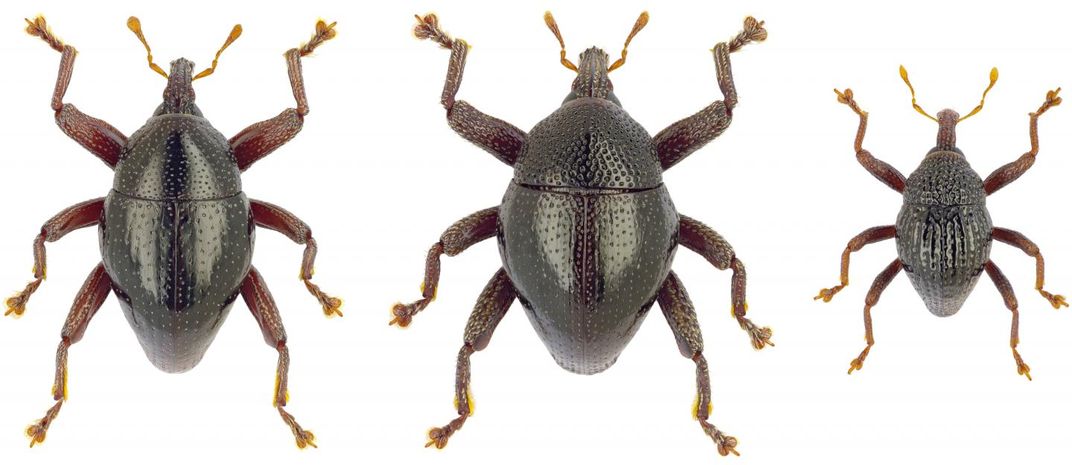These 103 Beetle Species Have a Mix of Pop Culture-Inspired Names
Entomologists named the newly discovered species after Star Wars Jedi master Yoda, Greek goddess Artemis, French comic book character Asterix
:focal(699x534:700x535)/https://tf-cmsv2-smithsonianmag-media.s3.amazonaws.com/filer/76/f2/76f21246-31d9-4c94-acca-09b086d0c472/194376_web.jpg)
More than 100 newly discovered beetle species native to the Indonesian island of Sulawesi boast an eclectic set of names derived from pop culture, scientific history and even Greek mythology.
As Jessica Boddy reports for Popular Science, the 103 species—recently catalogued in the journal ZooKeys—include weevils, or tiny beetles, named after Star Wars Jedi master Yoda, naturalist Charles Darwin and Greek hunting goddess Artemis. Three characters from the French comic book series The Adventures of Asterix, as well as DNA pioneers Francis Watson and James Crick, also lend their names to the diverse trove of insects.
According to Earther’s Jake Buehler, the newly described species all belong to the Trigonopterus genus. These egg-shaped, long-snouted weevils roam the densely forested islands between Asia and Australia, but until now, they had largely eluded scientists studying the otherwise biodiverse island of Sulawesi. Previously, the only known member of the genus spotted on Sulawesi was T. fulvicornis, a species described in 1885.
“We had found hundreds of species on the neighboring islands of New Guinea, Borneo and Java,” lead author Alexander Riedel, an entomologist at Germany’s Museum of Natural History Karlsruhe, explains in a statement. “Why should Sulawesi with its lush habitats remain an empty space?”
Working with Raden Pramesa Narakusomo of the Indonesian Institute of Sciences, Riedel conducted field surveys of the island and gathered several thousand weevil specimens. To determine whether the insects constituted distinct species, the pair examined the petite critters’ physical characteristics and sequenced their DNA.
The results of this analysis not only confirmed the scientists’ suspicion that Sulawesi was home to far more than a solitary Trigonopterus species, but also highlighted the island’s untapped potential. In a statement, Narakusomo says, “Our survey is not yet complete and possibly we have just scratched the surface.”

Crucially, Nick Porch observes for the Conversation, Earth’s beetles include an estimated 387,000 formally described species. Still, researchers believe that around three-fourths of the insects remain unidentified—and as Brett Ratcliffe, an entomologist at the University of Nebraska who was not involved in the study, points out to Popular Science’s Boddy, the window for unearthing these hidden species is rapidly closing due to climate change-driven extinction.
Given the time crunch surrounding such discoveries, entomologists often view the naming process as a necessary evil. Lead author Riedel tells Boddy that he and colleagues from Germany and Indonesia were tasked with naming 101 New Guinea weevil species for a 2013 study. Rather than dedicating valuable research time to concocting unique names, they simply opened a New Guinean phonebook and chose surnames at random, transforming “Morea,” for example, into T. moreaorum.
The Conversation’s Porch outlines a more conventional approach, noting that most researchers base names on the locality where a species was discovered, the collector in question or a unique set of physical characteristics. Riedel and Narakusomo used this naming method for the majority of their finds, according to Earther’s Buehler: T. incendium is named for the Tanjung Api, or Cape of Fire, region in which it was found, while T. squalidulus is recognized for its dirt-encrusted exoskeleton.
In other instances, the entomologists decided to get creative. As a press release reports, T. obelix, named in honor of the rotund Asterix character Obelix, is decidedly larger than T. asterix and T. idefix, which derive their names from Obelix’s comparatively demure companions. Fittingly, the researchers add in the study, a small, greenish forest-dweller is dubbed T. yoda.
The new ZooKeys paper is far from the first to draw inspiration from pop culture: Last year, Ratcliffe published a monograph detailing three scarab beetles named after “Game of Thrones” fan favorite Daenerys Targaryen’s dragons. And in 2016, a separate ZooKeys study announced the discovery of T. chewbacca, a black weevil whose dense cluster of scales reminded researchers of Han Solo’s Star Wars companion.
“When you create names like these, you do it to gain a little bit of notoriety and bring public attention to it,” Ratcliffe told the Omaha World-Herald’s Chris Peters in December 2018. “We’re still discovering life on Earth. One of every four living things on Earth is a beetle. We haven’t discovered them all. We’re not even close.”
/https://tf-cmsv2-smithsonianmag-media.s3.amazonaws.com/accounts/headshot/mellon.png)
/https://tf-cmsv2-smithsonianmag-media.s3.amazonaws.com/accounts/headshot/mellon.png)